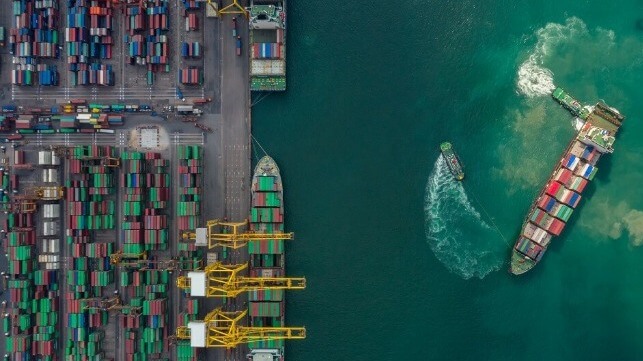Port Decarbonization: Snapshot of a Sector in Transition

 Panos Koutsourakis, Vice President of Global Sustainability of the American Bureau of Shipping, shares trends and learnings from a recent survey into the targets, trends and technologies of port decarbonization.
Panos Koutsourakis, Vice President of Global Sustainability of the American Bureau of Shipping, shares trends and learnings from a recent survey into the targets, trends and technologies of port decarbonization.
Across our blue planet, ships transit the oceans and waterways to connect far-flung economies. Their cargoes help to house, power, move and feed billions of people. Cost-effective over long distances in the way no other transport system is – adding, for example, just 0.3p to a £2.50 cup of coffee - sea transport is vital to global prosperity and underpins our modern way of life. But our way of life needs to change if the world is to avoid catastrophic global warming, and that means change for the maritime industries too.
From cleaner burning fuels and fuel cells to AI routing and wind-assisted tech, much of this change is focused on reducing the fuel burn of the vessels. But the shore-side infrastructure, from bunkering facilities and storage tanks to the cranes, trucks and trains that load and unload cargos as part of a seamless global supply chain, also needs to be weaned off fossil fuels. It’s estimated that ports emit around 2% of global carbon dioxide (CO2) emissions, much of which come from sources outside the direct control of the port, including vessels, rail and trucks.
The port challenge
It’s hard to overstate the scale of this challenge. There are more than 300 ports in the United States, handling a wide array of goods, commodities and people. US ports support the transport of 40% of all US goods to the tune of $2.1 trillion, support 2.5 million jobs, including 1 million port workers on average salaries of $98,000, and generate $311 billion in economic activity. Ports are the leading transportation mode for US international freight trade by weight and value, handling 1.6 billion tons of imports and exports in 2021.
And the biggest are city-sized. Take the Port of Los Angeles, for example, the busiest seaport in the Western Hemisphere, which occupies 7,500 acres of land and water along 43 miles of waterfront. It operates, among other things, more than 23,000+ drayage trucks (the vast majority of which are diesel-fuelled), 83 ship-to-shore container cranes and handles cargos ranging from avocados to zinc. Transitioning something this big, this busy and this strategic to a zero-emission operation is a huge task.
The drive to decarbonize
To better understand this challenge, and provide a timely snapshot of progress to date, the American Bureau of Shipping joined forces with the American Association of Port Authorities (AAPA). We conducted a survey and follow-up interviews to better understand the decarbonization landscape, and how ports plan to navigate their way to a zero-carbon future.
ABS and AAPA found that the majority (69%) of surveyed ports have set formal goals for decarbonization, including some fully-fledged net-zero or carbon-neutral goals that encompass emissions both in and out of the ports’ direct control.
The drivers for these programs varied widely, with the most commonly cited motivators being internal commitments, local community pressure and customer demand. Interestingly, only 20% of respondents said pressure from the authorities (federal, state or local governments) was the main driver of their decarbonization effort. It seems that wider network effects are weighing on organizations to act when it comes to the climate and local stakeholders. It also suggests, however, that there’s considerable scope for stiffer targets from regulators to accelerate progress.
This matters because decarbonization will not come cheap. Indeed, according to the APAA, there are already ‘$50 billion of green energy projects in various lifecycle stages’ across the industry, and delivering these in a timely fashion will require substantial funding and potentially more clarity from regulators. It’s little wonder, when asked to cite the biggest hurdles to decarbonization, that nine out of ten (90%) of our surveyed ports cited financial constraints, followed by technology readiness (62%) and equipment performance constraints (45%).
These three factors are part of the same equation: decarbonized alternatives require significant investment to move them from the drawing board, through the pilot, proof of concept, certification and into operational viability. These are not challenges that ports can overcome by themselves. It requires an ecosystem of partners, including regulators, all working to decarbonize the supply chain, both shoreside and at sea.
Funding the transition
Given the scale of the investment required to decarbonize, grant funding is and will continue to be crucial. When it comes to federal support, the Bipartisan Infrastructure Law (BIL) and Inflation Reduction Act (IRA) have opened the faucets for clean energy funding and turbo-charged the nation’s energy transition. Forecasts suggest projects delivered under IRA will reduce US economy-wide emissions by up to 40% by 2030.
Over half of our respondents receive grant funds under the Diesel Emissions Reduction Act (DERA) program, while more than 40% are recipients of the Port Infrastructure Development Program (PIDP) program. Our survey didn’t include two new subsidies under the EPA’s $3 billion Clean Ports Program as the Notice of Funding Opportunity (NOFO) was only released in February 2024. These funding rounds – the Zero-Emission Technology Deployment Competition and the Climate and Air Quality Planning Competition – are now open and are expected to become a leading source of federal funds for ports going forward.
Beyond the federal programs, there are other sources of funding for decarbonization projects. Our research found almost three-quarters of surveyed ports were applying for state government funding programs to support their decarbonization aims and these are likely to remain important.
Cooperation and collaboration
Given that ports are gateways to world commerce, trade and travel, this decarbonization effort is not merely a domestic challenge. Ports will need to work across international supply chains to find solutions that work. And beyond the port limits, there will need to be cooperation and collaboration with a wide range of utility companies, OEMs and other suppliers in order to switch from fossil fuels to green power.
Electrification is a key element of the energy transition and the port-utility relationship is going to be key. Our survey found 42% of responding ports have received some financial support in the installation of charging infrastructure and appear to have a good partner in their utility providers. However, this support appears to stop at the meter, with the costs on the customer side mostly borne by ports.
Further ahead, the electrification agenda is going to require collaboration not just between port and utility but also regulatory bodies. Almost half our respondents expect power demand to increase by over five times over the next ten years, with 11% thinking this could increase tenfold. This could potentially signal a formidable trend that will require significant changes in transmission planning in some regions.
Given the investment and timescales involved in such a seismic shift in power demand, at a time when shipping volumes only look set to increase, the cooperation, conversations and consultations need to be underway so that decarbonization stays on track to deliver the world we all want.
Panos Koutsourakis is Vice President of Global Sustainability of the American Bureau of Shipping.
The opinions expressed herein are the author's and not necessarily those of The Maritime Executive.
No comments:
Post a Comment